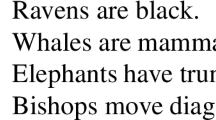Abstract
The generic pronoun one (or its empty counterpart, arbitrary PRO) exhibits a range of properties that show a special connection to the first person, or rather the relevant intentional agent (speaker, addressee, or described agent). Generic one typically leads to generic sentences whose generalization is obtained from a first-person experience or action or else is meant to be immediately applicable to the relevant agent himself (in particular the addressee). I will argue that generic one involves generic quantification in which the predicate is applied to a given entity ‘as if’ to the relevant agent himself. This is best understood in terms of simulation, a central notion in some recent developments in the philosophy of mind and cognitive science (Simulation Theory). generic one involves ‘generic simulation’, roughly ‘putting oneself into the shoes of anyone meeting relevant conditions. Formally, this means that generic one introduces a complex variable, consisting of an ordinary variable and a ‘mode of presentation’ of the relevant intentional agent, namely the property of being identical to that agent. Generic one, like other pronouns acting as bound variables, may also introduce just an ordinary variable. In both cases, the ordinary variable needs to be bound by a sentential generic operator.
Similar content being viewed by others
References
Carlson G. (1995). Truth-conditions of generic sentences: Two Contrasting views. In: Carlson G.N., Pelietier F.J. (eds). The generic book. University of Chicago Press, Chicago, pp. 224-237
Castaneda H.-N. (1966). He*: A study in the logic of self-consciousness. Ratio, 8, 130-157
Castaneda H.-N. (1967). The logic of self-attributions to others. American Philosophical Quarterly, 4, 85-100
Chierchia G. (1990). Anaphora and attitudes De Se. In: Bartsch R et al. (eds). Language in action. Foris Publications, Dordrecht, pp. 1-31
Chierchia G. (1995). The variability of impersonal subjects. In: Bach E et al. (eds). Quantification in natural language. Kluwer Academic Publishers, Dordrecht, pp. 107-143
Chomsky N. (1980). On binding. Linguistic Inquiry 11(1): 1-46
Chomsky, N. (1981). Lectures on government and binding, MIT Press.
Cohen A. (1999). On the generic use of indefinite singulars. Journal of Semantics, 18(3):183-209
Davies M., Stone T. (eds). (1995). Mental simulation, Evaluations and applications. Blackwell, Oxford
Evans G. (1982). Self-identification. In: McDowell Y (eds). Varieties of reference. Oxford University Press, Oxford, pp. 205-233
Fodor J. (1975). The language of thought. Cornell University Press, Ithaca, NY
Forbes G. (1997). How much substitutivity? Analysis, 57(2):109-113
Gaerdenfors P. (1986). Belief revision and the Ramsey test for conditionals. Philosophical Review, 95:81-93
Giorgi A., Longobardi P. (1991). The syntax of noun phrases: Configuration, parameters, and empty categories. Cambridge University Press, Cambridge
Goldman A.I. (1989). Interpretation psychologized. Mind and Language, 4:161-185
Goldman, A.I (1995). In defense of simulation theory. In M. Davies , & T. Stone (Eds.), Mental simulation: Evaluation and applications. Oxford: Blackwell.
Gordon R.M. (1986). Folkpsychology as simulation. Mind and Language, 1, 158-171
Gordon, R. M. (1995a). The simulation theory: Objections and misconceptions. In M. M. Davies, & T. Stone (Eds.), Mental simulation: Evaluation and applications. Oxford: Blackwell.
Gordon, R. M. (1995b). Simulation without introspection or inference from me to you. In M. Davies, & T. Stone (Eds.).
Heal, J. (1986). Replication and functionalism. In J. Butterfield (Ed.), Language, mind, and logic. Cambridge: Cambridge University Press.
Heim, I. (1982). The semantics and definite and indefinite noun phrases. PhD dissertation, University of Massachusetts at Amherst.
Higginbotham, J. (2003). Remembering, imagining, and the first person. In A. Barber (Ed.), Epistemology of language (pp. 496-533). Oxford: Oxford University Press.
Kadmon N., Landman F. (1993) Any. Linguistics and Philosophy, 16:355-422
Kamp H. (1981). A theory of truth and representation. In: Groenendijk J et al. (eds). Truth interpretation and information. Dordrecht, Foris, pp. 277-322
Kratzer, A. (1998). More structural analogies between pronouns and tense. In D. Strolovitds, & A. Lawson (Eds.), Proceedings of SALT 8 (pp. 92-110). Thaca, NY: CLC Publications.
Kratzer, A. (2006). Indefinites and the operators they depend on: From Japanese to Salish. In G. N. Carlson, & F. J. Pelletier (Eds.), Reference and quantification. The partee effect. Stanford: CSLI Publications.
Krifka, M., et al. (1995). Genericity. An introduction. In G. V. Carlson, & F. Pelletier (Eds.), The generic book. Chicago: Chicago University Press.
Lasnik H. (1981). On two recent treatments of disjoined reference. Journal of Linguistic Research, 1(4):48-58
Lewis D. (1975). Adverbs of quantification. In: Keenan E (eds). Formal semantics of natural language. Cambridge University Press, Cambridge, pp. 3-15
Lewis D. (1979). Attitudes De Dicto and De Se. The Philosophical Review, 88, 513-543
Perry, J. (1996). The self. In Routledge Encyclopedia of Philosophy.
Ramsey, F. P. (1931). General propositions and causality. In The foundations of mathematics (pp. 237-255). London: Routledge and Kegan.
Recanati F. (2002). Varieties of simulation. In: Dokic J., Proust J (eds). Simulation and knowledge of action. John Benjamins, Amsterdam, pp. 151-171
Rosenthal, D. (2003). Unity of consciousness and the self. Proceedings of the Aristotelian Society, 23(3), 325-352.
Safir K. (2000). Keeping one’s reference constant. Manuscript, Rutgers University
Saul J. (1997). Substitution and simple sentences. Analysis, 57(2):102-108
Shoemaker S. (1968). Self-reference and self-awareness. Journal of Philosophy, 65(19):555-567
Author information
Authors and Affiliations
Corresponding author
Additional information
I would like to thank Chris Peacocke for fruitful discussions at the initial stage of this work, in particular for pointing out the connection to Simulation Theory. I would furthermore like to thank Mike Martin, Dominique Sportiche, Robert Stalnaker, Ede Zimmermann, and audiences at the University of Amsterdam, Rutgers University, and especially the Institut Jean Nicod and the Ecole Normale Superieure in Paris for discussions.
Rights and permissions
About this article
Cite this article
Moltmann, F. Generic one, arbitrary PRO, and the first person. Nat Lang Semantics 14, 257–281 (2006). https://doi.org/10.1007/s11050-006-9002-7
Received:
Accepted:
Published:
Issue Date:
DOI: https://doi.org/10.1007/s11050-006-9002-7




